- Author Jason Gerald [email protected].
- Public 2023-12-16 10:50.
- Last modified 2025-01-23 12:04.
Lemon trees thrive, even if you don't plant them in a warm location. You can create a suitable environment for this plant by figuring out when is the best time to move it indoors, and watering it regularly so that the plant does not run out of water. If the lemon tree is 2 to 3 years old, you can harvest about 10-30 lemons each year!
Step
Part 1 of 3: Creating the Ideal Environment
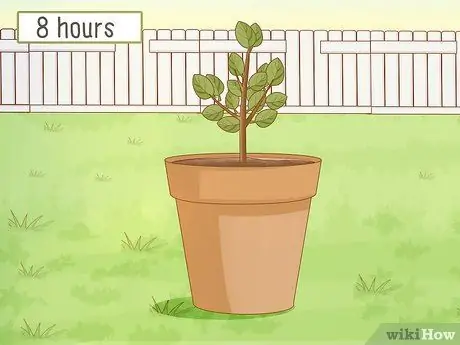
Step 1. Place the tree outdoors if you live in a warm, temperate climate
As long as the temperature at night is not less than 5 °C, you can place the lemon tree in a pot outside. If the weather is bad, put a potted lemon tree indoors to secure it.
If you live in an area that gets at least 8 hours of sun every day of the year, and the temperature never drops below 5-7 °C, you can plant lemons in your garden soil outside
Do you know?
Lemons thrive outdoors in areas such as India, Italy, Indonesia, Florida, and California.
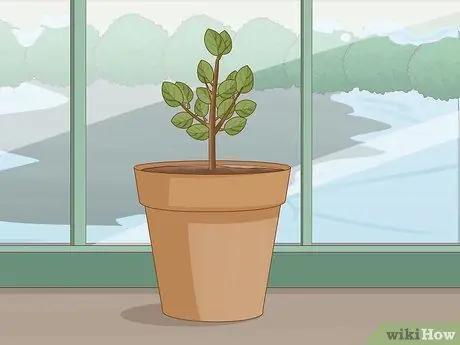
Step 2. Place the lemon tree indoors in winter (if you live in a country with 4 seasons)
If temperatures start to drop and frost begins to form above the ground, move the lemon tree to a sunroom, patio, greenhouse, or other area where it can get a lot of sunlight through the windows. Lemon trees can die if exposed to frost. So, always pay attention to the weather forecast so that you can move it indoors at the right time.
Dwarf lemons are an ideal variety if you want to keep them indoors. This variety produces a lot of fruit, but the tree doesn't get bigger so you can move it easily. Dwarf lemons will grow to a maximum of 1.5 to 2 meters tall, and you can prune them to make them smaller if you wish
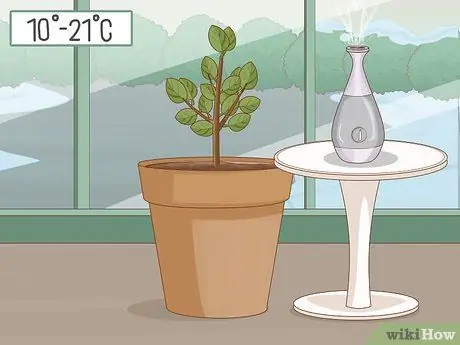
Step 3. Maintain the ideal temperature, which is around 10-21 °C
When the weather is hot, it doesn't matter if the temperature is over 21 °C during the day because the temperature will turn colder at night. If you are placing the tree indoors, take care that the temperature is neither too low nor too high. During winter (when the air becomes drier), don't let the temperature get too hot for the tree.
If the climate in your area is very dry, use a humidifier when the tree is moved indoors to keep the climate ideal, at around 50% humidity. If the climate where you live allows lemon trees to be grown outdoors, you don't have to worry about humidity levels
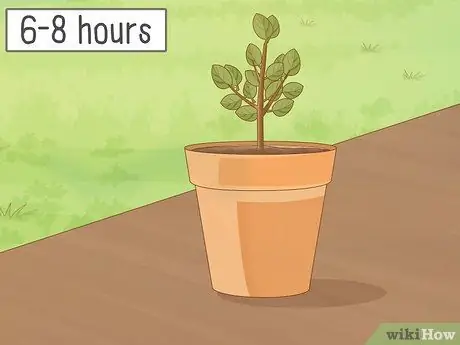
Step 4. Make sure the tree gets at least 6-8 hours of sun every day
Place the tree in a place that gets direct sunlight. Do not place it in a location that is shaded by other plants. Depending on the time of day, move the tree around your patio or yard to get maximum sunlight. If you're placing it indoors, you'll want to move it somewhere else at the change of seasons so that the tree always gets as much sunlight as possible.
In areas that are often cloudy with dark weather, you can buy a light for tree growth (grow light). These lights can be purchased on the internet or nurseries
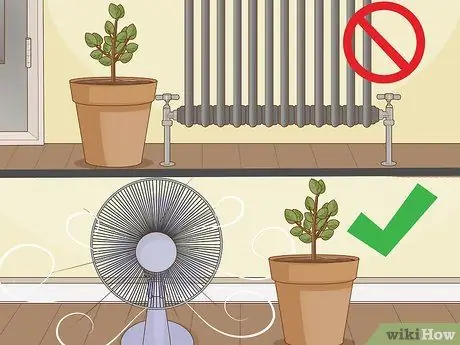
Step 5. Keep the tree away from radiators or other heat sources
If you are placing the tree indoors, keep the tree away from heat sources as this can dry out the leaves and soil. While sunlight and natural heat are great for trees, excessive dry heat can kill trees.
If possible, place the tree in a room with a sitting fan or ceiling fan. Air circulation will help the tree to stay healthy. Run the fan for a few hours each day
Part 2 of 3: Fertilizing and Watering Plants
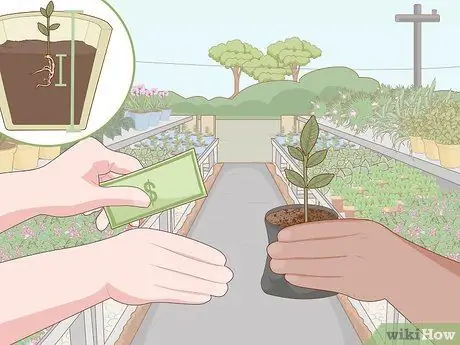
Step 1. Use a well-draining pot that is 25% larger than the lemon tree's root ball
The root ball is a network of roots to which the clod of earth attaches. If you bought a tree at the nursery, the tree may have been placed in a pot of the appropriate size. Check with the seed seller to be sure. If you want to replace the pot, look for a 20 liter pot for 2-3 year old plants, or a 40 liter pot for plants older than that.
Pots that are more than 60 liters will be difficult to move
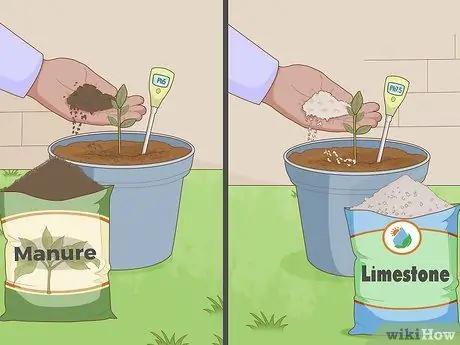
Step 2. Choose a compostable soil that drains water easily to fill the root ball
Use sandy or loamy soil (a mixture of clay, sand, and humus) because it has good drainage. Do not use clay or soil that is too alkaline. Top up the root ball (the tangle of roots and soil stuck to it), and stop adding soil when you reach the root base.
- Lemons are hardy plants and can grow in a variety of soil types, although loamy soils are the most preferred. If you want to test pH levels, try to keep the soil at a pH between 5.5 and 6.5 for optimal tree growth.
- If the soil is too acidic, add alkaline materials such as manure and compost to the soil.
- If the soil is less acidic, you can add something like agricultural lime.
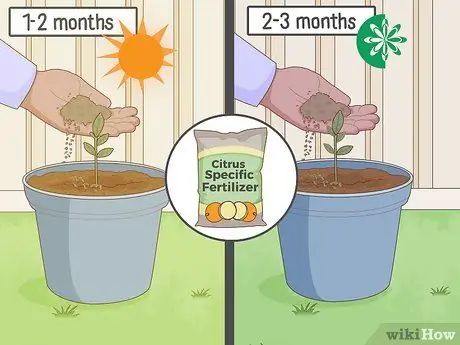
Step 3. Fertilize only on the soil surface so that the tree roots are not disturbed
Fertilize every 1-2 months in the rainy season and 2-3 months in the dry season. Use a fertilizer specifically designed for citrus, and only sprinkle it on top of the soil. Do not mix it with soil.
Lemon trees will grow actively in the rainy season, and are usually inactive during the dry season
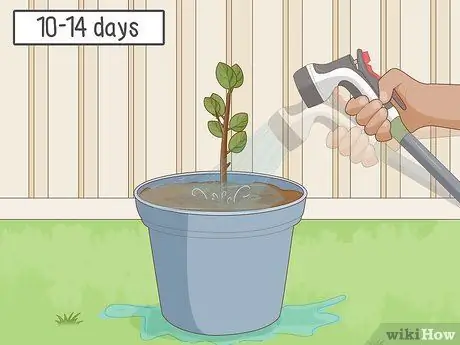
Step 4. Water the plant every 10-14 days
Water the tree while slowly counting to 20 (or 20 seconds). Stop watering if water starts to come out of the bottom of the pot. If the water hasn't come out after 20 seconds of watering, continue counting and watering the plant for another 10 seconds. If the weather is very dry, try to pay attention to the soil and leaves. If the soil feels dry to the touch or the leaves wilt, water it. When the weather is very hot, you may need to water it once or twice a week.
Tip:
Insert your finger into the soil until it reaches the second knuckle. If the soil is still damp, wait another day or two to water the plants.
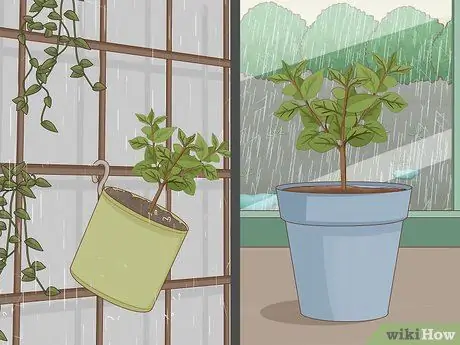
Step 5. Place the tree in a location that is not waterlogged
Although it requires a lot of water, lemon plants should not be in a waterlogged area. If you are placing the pot outdoors, place the pot in a location where there is no standing rain, such as a garden wall or on the highest slopes.
If it's raining heavily where you live, move potted plants indoors, or place pots under a tarp until the rain stops
Part 3 of 3: Harvesting and Pruning Lemons
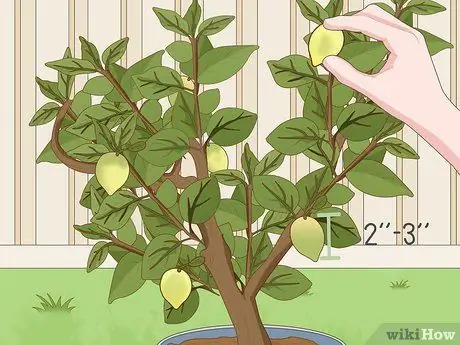
Step 1. Pick the lemon when the fruit is firm and about 5 to 8 cm in size
Pick the lemon green if you prefer a more sour taste. The yellower the lemon peel, the sweeter it will taste. Lemons will continue to ripen even after being picked from the tree.
- Maybe the lemon is still green even though it's the right size. This is not a problem. Size is more important than fruit color.
- Lemons will be slippery if left on the tree too long.
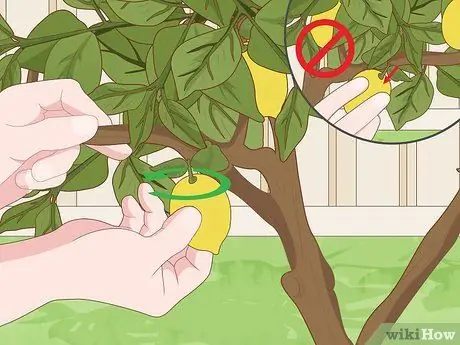
Step 2. Gently twist the fruit until the stem is cut off
Hold the lemon firmly with one hand, then twist the stem. The lemons will come off easily. You can also pick lemons from the tree using pruning shears.
Don't pick up the lemon by pulling it. This can damage branches and can even cause them to snap and fall off the tree
Do you know?
Lemon can not only be used as an additive in food and drinks. You can spin it in a garbage disposal machine to get rid of the smell in the sink. Rub lemon on bathroom and kitchen faucets to give it a shine. Apply lemon juice on blackheads and pimples to clear them.
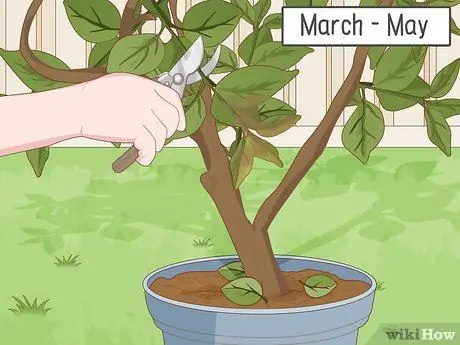
Step 3. Prune the lemon plant from March to May to keep the tree healthy
The best time to do pruning is after harvest, but before new shoots appear. Depending on the climate in which you live, prune lemon trees at the end of the dry season or the beginning of the rainy season.
Pruning is very important to keep the tree healthy and to encourage new growth
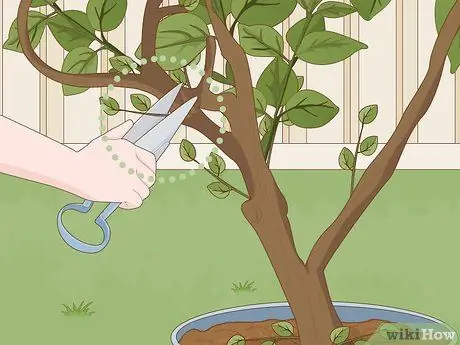
Step 4. Use pruning shears to trim the new shoots to half their original length
Cut the branches at a 45-degree angle and do not trim them near the main stem. Focus on pruning long, bony branches, and leaving thick, strong branches. Prune any branches that are hanging low and pointing downwards towards the ground.
Take the time to remove dead leaves from tree branches, and clean up any fallen leaves on the ground
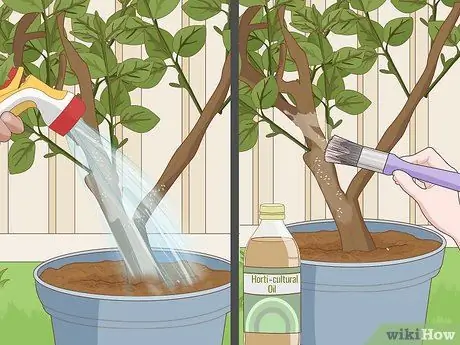
Step 5. Watch for pests and deal with problems that arise
Pruning is a great first step to keep pests from nesting in lemon trees. If you encounter aphids or spider mites, remove them from the tree by spraying them with a water hose (do this outdoors). If the problem doesn't go away, or another pest appears on the plant, use an insecticide or horticultural oil to protect the tree. Consult a professional and follow the instructions given so you don't accidentally damage the lemon tree. Some of the common pests that attack lemon trees include:
- Red mites: tiny red insects that feed on the twigs and leaves of citrus plants
- Spider mites: tiny white insects that are often found in cold environments
- The citrus plant mealybug: a small, oval, flat, wingless insect. This pest has a waxy coating that looks bubbly
- Orange plant white fly: a small, white, winged insect that clings to the underside of an orange leaf
Tips
- Start with a tree that is large and strong, which can be purchased at a seed seller. Trees from seed may take from 2-3 years to produce their first fruit, which makes them a good long-term investment.
- If lemons are placed indoors, you will need to pollinate them yourself for the plants to bear fruit. However, you don't need to do this if the lemons are placed outdoors.
- Various diseases can threaten lemon trees. You must know the symptoms of the disease and take the necessary action.






